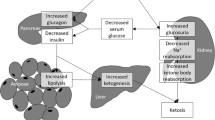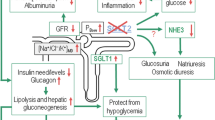Abstract
Diabetic ketoacidosis is an infrequent but life-threatening acute complication of diabetes, affecting predominantly patients with type 1 diabetes, children, and pregnant women, where ketosis is usually associated with marked hyperglycemia. Recently, an increasing number of cases have been reported of euglycemic diabetic ketoacidosis in patients with type 2 diabetes receiving sodium-glucose cotransporter 2 inhibitor treatment in routine practice. There is a minor, but not negligible diabetic ketoacidosis risk associated with this drug class, which was not seen in randomized clinical trials. However, sodium-glucose cotransporter2 inhibitors increase the risk of ketosis by increasing glucagon secretion in the pancreas and decreasing the renal excretion of 3-hydroxybutyrate and acetoacetate. When used in addition to insulin, any insulin dose reduction required to avoid hypoglycemia may lead to insufficient suppression of lipolysis and ketogenesis. sodium-glucose cotransporter2 inhibitor-induced loss of urinary glucose encourages euglycemia. Normo-glycemic or near-normoglycemic diabetic ketoacidosis represents a major threat to the health and well-being of a patient, because it may occur undetected and without any indicative hyperglycemia. In consequence, patients on sodium-glucose cotransporter2 inhibitors are recommended to perform regular blood ketone tests since they are not alerted to incipient diabetic ketoacidosis by glucose testing alone. This option is offered by several blood glucose meters that can also measure ketones with a separate ketone strip or in one case by an automatic parallel ketone assessment from the same strip. The need for extra testing and the associated costs may be a barrier to patient acceptance of this risk mitigation procedure. However, patients who are at risk for euglycemic diabetic ketoacidosis when being treated with sodium-glucose cotransporter2 inhibitors should be specially advised to monitor blood ketone levels on a regular basis.
Similar content being viewed by others
Abbreviations
- AACE:
-
American Association of Clinical Endocrinologists
- ACE:
-
American College of Endocrinology
- ß-OHB:
-
- ß-hydroxybutyrate
- DKA:
-
Diabetic ketoacidosis
- SGLT2:
-
Sodium-glucose cotransporter 2
References
L. Laffel, Sick-day management in type 1 diabetes. Endocrinol. Metab. Clin. North. Am. 29, 707–723 (2000)
K. Casteels, C. Mathieu, Diabetic ketoacidosis. Rev. Endocr. Metab. Disord. 4, 159–166 (2003)
G.E. Umpierrez, A.E. Kitabchi, Diabetic ketoacidosis: risk factors and management strategies. Treat. Endocrinol. 2, 95–108 (2003)
American Diabetes Association: Standards of Medical Care in Diabetes. Diabetes Care 39(Suppl.1), S1-S112 (2016)
M.E. van Albada, W.M. Bakker-van Waarde, Recurrent nightly ketosis after prolonged exercise in type 1 diabetes - the need for glycogen replacement strategies. Case report and review of literature. Pediatr. Diabetes 17, 531–534 (2016)
M.R. Burge, K.J. Hardy, D.S. Schade, Short-term fasting is a mechanism for the development of euglycemic ketoacidosis during periods of insulin deficiency. J. Clin. Endocrinol. Metab. 76, 1192–1198 (1993)
N. Tarif, W. Al Badr, Euglycemic diabetic ketoacidosis in pregnancy. Saudi. J. Kidney Dis. Transpl. 18, 590–593 (2007)
W. Ogawa, K. Sakaguchi, Euglycemic diabetic ketoacidosis induced by SGLT2 inhibitors: possible mechanism and contributing factors. J. Diabetes Investig. 7, 135–138 (2016)
N. Erondu, M. Desai, K. Ways, G. Meininger, Diabetic ketoacidosis and related events in the canagliflozin type 2 diabetes clinical program. Diabetes Care 38, 1680–1686 (2015)
B.W. Bode, S.K. Garg, The emerging role of adjunctive noninsulin antihyperglycemic therapy in the management of type 1 diabetes. Endocr. Pract. 22, 220–230 (2016)
A.L. Peters, R.R. Henry, P. Thakkar, C. Tong, M. Alba, Diabetic ketoacidosis with canagliflozin, a sodium-glucose cotransporter 2 inhibitor, in patients with type 1 diabetes. Diabetes Care 39, 532–538 (2016)
H. Storgaard, L.L. Gluud, C. Bennett, M.F. Grøndahl, M.B. Christensen, F.K. Knop, T. Vilsbøll, Benefits and harms of sodium-glucose co-transporter 2 inhibitors in patients with type 2 diabetes: a systematic review and meta-analysis. PLoS. ONE. 11, e0166125 (2016)
A.J. Scheen, SGLT2 inhibition: efficacy and safety in type 2 diabetes treatment. Expert. Opin. Drug. Saf. 14, 1879–1904 (2015)
B. Zinman, C. Wanner, J.M. Lachin, D. Fitchett, E. Bluhmki, S. Hantel, M. Mattheus, T. Devins, O.E. Johansen, H.J. Woerle, U.C. Broedl, S.E. Inzucchi, Empagliflozin, cardiovascular outcomes, and mortality in type 2 diabetes. N. Engl. J. Med. 373, 2117–2128 (2015)
R.P. Monica Reddy, S.E. Inzucchi, SGLT2 inhibitors in the management of type 2 diabetes. Endocrine 53, 364–372 (2016)
C. Bonner, J. Kerr-Conte, V. Gmyr, G. Queniat, E. Moerman, J. Thévenet, C. Beaucamps, N. Delalleau, I. Popescu, W.J. Malaisse, A. Sener, B. Deprez, A. Abderrahmani, B. Staels, F. Pattou, Inhibition of the glucose transporter SGLT2 with dapagliflozin in pancreatic alpha cells triggers glucagon secretion. Nat. Med. 21, 512–517 (2015)
M.G. Pedersen, I. Ahlstedt, M.F. El Hachmane, S.O. Göpel, Dapagliflozin stimulates glucagon secretion at high glucose: experiments and mathematical simulations of human A-cells. Sci. Rep. 6, 31214 (2016)
J.J. Cohen, F. Berglund, W.D. Lotspeich, Renal tubular reabsorption of acetoacetate, inorganic sulfate and inorganic phosphate in the do gas affected by glucose and phlorizin. Am. J. Physiol. 184, 91–96 (1956)
B.F. Palmer, D.J. Clegg, S.I. Taylor, M.R. Weir, Diabetic ketoacidosis, sodium glucose transporter-2 inhibitors and the kidney. J. Diabetes Complications. 30, 1162–1166 (2016)
G. Daniele, J. Xiong, C. Solis-Herrera, A. Merovci, R. Eldor, D. Tripathy, R.A. DeFronzo, L. Norton, M. Abdul-Ghani, Dapagliflozin. Enhances fat oxidation and ketone production in patients with type 2 diabetes. Diabetes Care 39, 2036–2041 (2016)
J. Rosenstock, E. Ferrannini, Euglycemic diabetic ketoacidosis: a predictable, detectable, and preventable safety concern with SGLT2 inhibitors. Diabetes Care 38, 1638–1642 (2015)
S.I. Taylor, J.E. Blau, K.L. Rother, SGLT2 inhibitors may predispose to ketoacidosis. J. Clin. Endocrinol. Metab. 100, 2849–2852 (2015)
V. Tsimihodimos, T.D. Filippatos, M. Elisaf, Effects of sodium-glucose co-transporter 2 inhibitors on metabolism: Unanswered questions and controversies. Expert. Opin. Drug. Metab. Toxicol. 17, 1–10 (2016). 2016 Nov 6. [Epub ahead of print]
T. Wood, A.J. Pang, J. Hallet, P. Greig, Euglycaemic ketoacidosis in a postoperative whipple patient using canaglifozin. BMJ Case Rep. Sep. 27, (2016)
O. Rashid, S. Farooq, Z. Kiran, N. Islam, Euglycaemic diabetic ketoacidosis in a patient with type 2 diabetes started on empagliflozin. BMJ Case Rep. pii: bcr2016215340 (2016)
B. Venkatesh, G. Moore, D. Gill, W. Kelly, Diabetic ketoacidosis precipitated by therapy with antidiabetic agents SGLT2 inhibitors: two cases. Crit. Care. Resusc. 17, 280–282 (2015)
T. Hayami, Y. Kato, H. Kamiya, M. Kondo, E. Naito, Y. Sugiura, C. Kojima, S. Sato, Y. Yamada, R. Kasagi, T. Ando, S. Noda, H. Nakai, E. Takada, E. Asano, M. Motegi, A. Watarai, K. Kato, J. Nakamura, Case of ketoacidosis by a sodium-glucose cotransporter 2 inhibitor in a diabetic patient with a low-carbohydrate diet. J. Diabetes Investig. 6, 587–590 (2015)
A. Kaur, S.J. Winters, Severe hypercalcemia and hypernatremia in a patient treated with canagliflozin. Endocrinol. Diabetes Metab. Case Rep. 2015, 150042 (2015)
F.B. Bonanni, P. Fei, L.L. Fitzpatrick, Normoglycemic ketoacidosis in a postoperative gastric bypass patient taking canagliflozin. Surg. Obes. Relat. Dis. 12, e11–e12 (2016)
T.J. Andrews, R.D. Cox, C. Parker, J. Kolb, Euglycemic diabetic ketoacidosis with elevated acetone in a patient taking a sodium-glucose cotransporter-2 (SGLT2) inhibitor. J. Emerg. Med. 52(2), 223–226 (2016)
J. Turner, T. Begum, R.D. Smalligan, Canagliflozin-induced diabetic ketoacidosis: case report and review of the literature. J. Investig. Med. High Impact Case Rep. 4, 2324709616663231 (2016)
M. Clement, P. Senior, Euglycemic diabetic ketoacidosis with canagliflozin: not-so-sweet but avoidable complication of sodium-glucose cotransporter-2 inhibitor use. Can. Fam. Physician 62, 725–728 (2016)
N. Candelario, J. Wykretowicz, The DKA that wasn't: a case of euglycemic diabetic ketoacidosis due to empagliflozin. Oxf. Med. Case Reports 2016, 144–146 (2016)
P.D. Farjo, K.M. Kidd, J.L. Reece, A case of euglycemic diabetic ketoacidosis following long-term empagliflozin therapy. Diabetes Care 39, e165–e166 (2016)
P. Roach, P. Skierczynski, Euglycemic diabetic ketoacidosis in a patient with type 2 diabetes after treatment with empagliflozin. Diabetes Care 39, e3 (2016)
H. Tahir, A. Wani, V. Daruwalla, N. Daboul, J. Sagi, Euglycemic diabetic ketoacidosis and severe acute kidney injury secondary to off-label use of sodium glucose cotransporter-2 inhibitor in a type 1 diabetic patient. J. Ayub. Med. Coll. Abbottabad 27, 923–924 (2015)
J.G. Sfeir, V.M. Montori, In insulin-treated type 1 diabetes, canagliflozin increased diabetic ketoacidosis. Ann. Intern. Med. 165, JC2 (2016)
M.A. Mancano, Nonconvulsive status epilepticus in elderly patients receiving SSRIs; Euglycemic diabetic ketoacidosis associated with canagliflozin use in a type 1 diabetic patient; Duloxetine-induced galactorrhea; Canagliflozin-associated severe hypercalcemia and hypernatremia; Vemurafenib-induced fanconi syndrome. Hosp. Pharm. 50, 756–760 (2015)
H. Harati, V. Sharma, A. Motazedi, Sodium-glucose cotransporter 2 inhibitor-associated diabetic ketoacidosis: Report of two cases with hyperglycemic ketoacidosis in type 1 diabetes. J. Diabetes 8, 165 (2016)
Y.Y. Chow, R. Worsley, D.J. Topliss, Lessons from the bedside: ketoacidosis and SGLT2 inhibitors. Med. J. Aust. 205, 191–192 (2015)
S. Kalra, R. Sahay, Y. Gupta, Sodium glucose transporter 2 (SGLT2) inhibition and ketogenesis. Indian J. Endocrinol. Metab. 19, 524–528 (2015)
J.S. Kum-Nji, A.R. Gosmanov, H. Steinberg, S. Dagogo-Jack Hyperglycemic, high anion-gap metabolic acidosis in patients receiving SGLT-2 inhibitors for diabetes management. J. Diabetes Complications 30, 611–614 (2017)
P. Urbain, H. Bertz, Monitoring for compliance with a ketogenic diet: what is the best time of day to test for urinary ketosis? Nutr. Metab. (Lond). 13, 77 (2016)
R. Alessandro, B. Gerardo, L. Alessandra, C. Lorenzo, P. Andrea, G. Keith, Z. Yang, P. Antonio, Effects of twenty days of the ketogenic diet on metabolic and respiratory parameters in healthy subjects. Lung 193, 939–945 (2015)
A. Modi, A. Agrawal, F. Morgan, Euglycemic diabetic ketoacidosis. Curr. Diabetes Rev. Apr. 21, PMID: 27097605 (2016)
P. Taboulet, L. Haas, R. Porcher, J. Manamani, J.P. Fontaine, J.P. Feugeas, J.F. Gautier, Urinary acetoacetate or capillary beta-hydroxybutyrate for the diagnosis of ketoacidosis in the emergency department setting. Eur. J. Emerg. Med. 11, 251–258 (2004)
L.M. Laffel, K. Wentzell, C. Loughlin, A. Tovar, K. Moltz, S. Brink, Sick day management using blood 3-hydroxybutyrate (3-OHB) compared with urine ketone monitoring reduces hospital visits in young people with T1DM: a randomized clinical trial. Diabetes Med. 23, 278–284 (2006)
B. Guerci, N. Tubiana-Rufi, B. Bauduceau, R. Bresson, A. Cuperlier, C. Delcroix, D. Durain, C. Fermon, J.P. Le Floch, C. Le Devehat, V. Melki, L. Monnier, H. Mosnier-Pudar, P. Taboulet, H. Hanaire-Broutin, Advantages to using capillary blood beta-hydroxybutyrate determination for the detection and treatment of diabetic ketosis. Diabetes Metab. 31, 401–466 (2005)
Y. Handelsman, R.R. Henry, Z.T. Bloomgarden, S. Dagogo-Jack, R.A. DeFronzo, D. Einhorn, E. Ferrannini, V.A. Fonseca, A.J. Garber, G. Grunberger, D. LeRoith, G.E. Umpierrez, M.R. Weir, American association of clinical endocrinologists and American college of endocrinology position statement on the association of SGLT2 inhibitors and diabetic ketoacidosis. Endocr. Pract. 22, 753–762 (2016)
Acknowledgements
A.P. has received research grants, speaker fees, and travel support from Abbott Diabetes Care, Inside Biometrics, Menarini Diagnostics, and Nova Diabetes Care.
Author information
Authors and Affiliations
Corresponding author
Ethics declarations
Conflict of interest
The authors declare that they have no other competing interests.
Rights and permissions
About this article
Cite this article
Pfützner, A., Klonoff, D., Heinemann, L. et al. Euglycemic ketosis in patients with type 2 diabetes on SGLT2-inhibitor therapy—an emerging problem and solutions offered by diabetes technology. Endocrine 56, 212–216 (2017). https://doi.org/10.1007/s12020-017-1264-y
Received:
Accepted:
Published:
Issue Date:
DOI: https://doi.org/10.1007/s12020-017-1264-y




